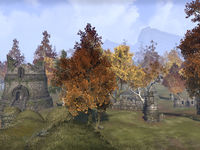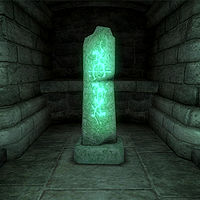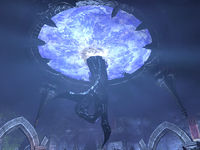Lore:Sancre Tor
| Sancre Tor | |
|---|---|
| Type | Ruin |
| Continent | Tamriel |
| Province | Cyrodiil |
| Region | Jerall Mountains |
| Appears in | Oblivion, Oblivion Mobile, ESO |

Sancre Tor (or the Golden Hill), also known as the Tor,[1] was an ancient fortified city in Colovia, located in the Jerall Mountains north of the city of Chorrol in what is now Cyrodiil.[2] It is said to be the mythical birthplace and final resting place of Reman Cyrodiil and his successors.[3][4] It is notable for the Fort Runestones placed throughout the complex during the First Era.[5]
History[edit]
First Era[edit]
The founding stories of Sancre Tor are conflicting and shrouded in myth. It is written that Alessia received the divine inspiration for her slave rebellion at the site of Sancre Tor, and afterwards founded her holy city there.[6] However, this conflicts with the story of Alessia's youth, where she was raised as a slave in the Ayleid city of Sard.[7] Apocryphal accounts describe Sancre Tor as an Ayleid holding which was taken by Alessia; the loss involved eight horns known as the Hallowed Clarions.[8]
Another origin myth claims that King Hrol gave his life by copulating with the spirit of Saint Alessia on the site of Sancre Tor, seemingly impregnating the earth. The small mound of mud left behind by their union soon grew into a small mountain (the "Golden Hill", also known as Hrol's Hillock), attracting a community of believers to settle there. After nine months, the shepherdess Sed-Yenna heard a cry from the top of the mountain, and climbed it to find the newborn Reman Cyrodiil, wearing the Chim-el Adabal on his forehead.[3]
Second Era[edit]
Sancre Tor fell into ruin following the fall of the Reman Dynasty. Many heroes and noblemen were buried in the crypts, including the Remans and their Dragonguard protectors. Within the main chamber of the catacombs are five tombs bearing epitaphs dedicated to Reman I, II and III, along with two other unmarked rulers (although it is implied these tombs belong to Kastav[nb 1] and Brazollus Dor).[9]
Priestesses of Dibella around Sancre Tor painted their ankles in the same fashion as the extinct Keptu circa 1E 2762.[UOL 1]
After its abandonment, Sancre Tor became a dark place, haunted by vast numbers of undead. Some time after the Soulburst of 2E 579, Sai Sahan and Kasura hid the Amulet of Kings in the ruins of Sancre Tor before being captured by Molag Bal. In 2E 582, the reformed Five Companions entered the ruins in an attempt to retrieve it. Mannimarco swiftly followed, raising more undead from their graves in an attempt to stop them. However, he was defeated in battle by the Vestige after revealing his plans to usurp Bal's godhood. He was then pulled into Coldharbour for his treachery, allowing the Companions to escape with the Amulet.[10]
By the late Second Era, Sancre Tor had once again become inhabited. In 2E 852, the city was captured by invading forces from High Rock and Skyrim during the Tiber War.[11] General Talos, who would later become Tiber Septim, recaptured the city that winter.[11] However, the city was in a strategically inconvenient position, and Talos abandoned it to again fall into ruins.[4]
Third Era[edit]
Many decades later, Tiber Septim was fatally wounded at another battle at Sancre Tor, where he died and ascended to become one of the Nine Divines.[12] The Blades built a shrine in the catacombs of Sancre Tor, on the spot where he had received the blessing of Akatosh.[13] It then served as a place of pilgrimage for the Blades for many years.
The old fortress of Sancre Tor was later corrupted by the Underking, prompting it to be sealed shut by the Grandmaster of the Blades in the thirty-sixth year of the reign of Tiber Septim.[14] The four mightiest Blades of the time, Alain, Valdemar, Rielus, and Casnar, never returned from the ruins and were cursed to undeath.[13] In the years after Tiber Septim's reign, it was gradually forgotten, decaying into a haunted ruin. The Hero of Kvatch visited the ruins in 3E 433 to recover the Armor of Tiber Septim, unsealing the ruins with the approval of the Blades. After freeing the four ancient Blades from undeath, their spirits aided the Hero in entering the Reman crypt and recovering the armor.[15] The Hero was also aided by a mysterious guardian known as Baynham.[16]
Notes[edit]
Gallery[edit]
-
Sancre Tor circa 2E 582 (ESO)
-
Sancre Tor circa 2E 582 (ESO)
-
Sancre Tor circa 3E 433 (Oblivion)
-
Molag Bal reaching forth from Coldharbour (ESO)
See Also[edit]
- For game-specific information, see the Oblivion and Elder Scrolls Online articles.
Books[edit]
- The Legendary Sancre Tor by Matera Chapel — An attempt to chronicle the rise and fall of Sancre Tor
- Battle of Sancre Tor — The story of how General Talos defeated the stronghold of Sancre Tor
References[edit]
- ^ The Song of Pelinal, v 3
- ^ Map of Cyrodiil
- ^ a b Remanada
- ^ a b The Legendary Sancre Tor — Matera Chapel
- ^ Arcane University lectures
- ^ Sai Sahan's dialogue in ESO
- ^ The Adabal-a — Morihaus
- ^ Closing the Octal Cage
- ^ Tomb of the Reman Emperors in Oblivion
- ^ Events of ESO
- ^ a b Battle of Sancre Tor
- ^ Oblivion Mobile dialogue
- ^ a b Jauffre's dialogue in Oblivion
- ^ Scripted message in Oblivion
- ^ Blood of the Divines quest in Oblivion
- ^ Events of Oblivion Mobile
Note: The following references are considered to be unofficial sources. They are included to round off this article and may not be authoritative or conclusive.







